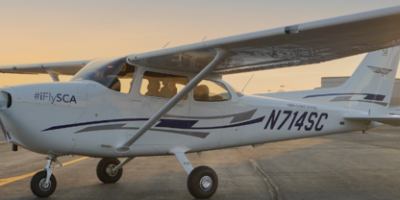Where you park your airplane might seem like a simple decision, but it affects maintenance costs, aircraft condition, convenience, and safety. I’ve done both hangars and tie-downs over the years. Here’s the real scoop on each option.
Quick Answer: Hangars cost $200-$1,500/month depending on location and type (T-hangar, community hangar, or private hangar). Protects aircraft from weather, reduces maintenance, prevents sun/hail damage, provides security. Tie-downs cost $50-$300/month. Aircraft sits outside exposed to weather – more maintenance, sun damage, corrosion risks, but way cheaper. For expensive or delicate aircraft, hangars are worth it. For older trainers in good climates, tie-downs work fine. Calculate the difference – if hangar costs $150/month more ($1,800/year), will it save you $1,800+ in reduced maintenance? Often yes.
Tie-Down Basics
Tie-down means your plane sits on the ramp, tied to anchors or chains in the ground. Three chains typically – one on each wing, one on the tail. Keeps it from blowing away in wind. That’s it. No walls, no roof, just open air parking.
Costs $50-$300/month depending on airport. Small rural airports might be $75/month, busy metros might be $200-$300/month. It’s the cheapest storage option by far. For someone flying an older aircraft and watching costs, tie-downs make sense financially.
You share the ramp with other tied-down aircraft. Parking spaces are assigned but you’re all out there together. Social if you like chatting with other pilots. Annoying if your neighbor parks too close or their tie-down ropes are drooping onto your plane.
Tie-Down Disadvantages
Weather beats up tied-down aircraft. Sun fades paint, cracks plastic windows, deteriorates interior. UV exposure destroys avionics screens over time. Windshields craze and need replacement sooner. Interior gets scorching hot in summer – 130°F+ easy. Ever try to get into a 172 that’s been sitting in August sun? It’s miserable.
Rain accumulates in weird places, causes corrosion. Tie-down aircraft in humid climates develop corrosion way faster than hangared aircraft. That’s more frequent corrosion inspections, more maintenance, more cost long-term.
Hail destroys tied-down aircraft. One hailstorm can total a plane – dimpled skins, cracked windscreens, damaged control surfaces. I’ve seen tens of thousands in damage from one storm. You can’t exactly run out and move the plane when hail’s forecasted at 2 AM.
Ice and snow are a pain. You’ll spend time brushing snow off, de-icing, preheating the engine in winter. Hangared aircraft just start. Tied-down aircraft in northern climates need engine pre-heaters, wing covers, all sorts of winter gear. Extra hassle and expense.
Security’s weaker. Anyone can walk up to your plane on the ramp. Vandalism, theft, people leaning on it or letting kids climb on it. Most airports have fencing and gates, but it’s not Fort Knox. Hangared aircraft are behind locked doors.
Tie-Down Advantages
It’s cheap. That’s the big one. Saving $100-$300/month versus a hangar adds up to $1,200-$3,600/year. For aircraft worth $30,000-$50,000, those savings matter. Put the money toward flying more or maintenance reserves.
Convenience sometimes. At some airports, tie-down spaces are right by the FBO or parking lot. Hangars might be a 10-minute drive across the airport. If you fly frequently, being close to your plane beats walking half a mile through hangar rows.
No waitlist usually. Hangars have years-long waitlists at popular airports. Tie-downs are generally available immediately. Want to base your plane somewhere specific? Tie-down might be your only option short-term.
In good climates (Arizona, Southern California, parts of Texas), tie-downs work okay. Low humidity, no hail, mild winters. Aircraft still degrade faster than hangared, but it’s not catastrophic. Lots of planes live outside their whole lives in good climates and do fine.
Hangar Types
T-Hangars: Individual units with doors, your plane goes in, door closes. Usually 40×40 feet – fits most single-engine aircraft comfortably. You’ve got your own space. Most common and affordable hangar option at $200-$600/month depending on location.
Community hangars: Big open building with multiple aircraft parked inside. You share the space with 5-20 other planes. Cheaper than T-hangars ($100-$400/month) but less convenient – sometimes you need to ask others to move their planes so you can get yours out. Works well if you don’t fly frequently or if everyone coordinates well.
Corporate/private hangars: Massive standalone buildings, often with office space, workshop areas, multiple bays. For serious owners with expensive aircraft or multiple planes. $1,000-$5,000+/month. Probably overkill unless you own a jet or multiple aircraft.
Hangar Advantages
Protection from weather’s the obvious one. No sun damage, no hail risk, no snow to clear, no rain causing corrosion. Your plane stays clean and nice. Avionics last longer, paint lasts longer, interior doesn’t crack and fade. Over 10-20 years, that’s thousands in reduced maintenance.
Security’s way better. Locked hangar, nobody’s messing with your plane. You can leave headsets, charts, tie-down gear, oil, cleaning supplies in the hangar. Can’t do that with tie-downs – anything not bolted down gets stolen eventually.
Temperature control (sort of). Hangars aren’t heated usually, but they’re way less extreme than outside. Summer day outside is 95°F, inside a hangar might be 85°F. Winter night outside is 15°F, hangar might be 30°F. Makes preflighting and starting way more comfortable.
You can work on your plane. Change oil, do minor maintenance, clean it thoroughly, install avionics – all easier in a hangar. Working on a plane on a windy ramp with rain threatening sucks. Doing it in your hangar is pleasant.
Insurance discounts sometimes. Hangared aircraft get 10-20% lower hull insurance premiums because claim rates are lower. Saves you $100-$300/year, which partially offsets hangar costs.
Hangar Disadvantages
Cost’s the big one. $200-$600/month adds $2,400-$7,200/year to fixed costs. For aircraft worth $50,000-$100,000, that’s 2.5-7% of value annually just for parking. Ouch.
Availability’s a problem at popular airports. Waitlists are years long at some places. I know pilots waiting 5+ years for T-hangars. You might not have the option even if you want it and can afford it.
Location sometimes. Hangars might be far from FBO/parking, less convenient for quick flights. Although most pilots consider the tradeoff worth it for the protection.
Cost-Benefit Analysis
Let’s say hangar costs $300/month more than tie-down ($3,600/year difference). Will you save $3,600+ in reduced maintenance and better aircraft condition?
Probably yes for newer aircraft. Paint job costs $15,000-$30,000 and lasts 10-15 years hangared, maybe 7-10 years tied-down. Interior costs $5,000-$15,000 and lasts longer hangared. Avionics repairs and replacements happen less frequently. Corrosion inspections and repairs are cheaper. Over 10 years, the hangar easily pays for itself in avoided costs.
Maybe for older aircraft. If you’ve got a 1970s trainer worth $30,000, spending $300/month on a hangar is questionable math. Tie it down, deal with the extra maintenance, save the money. When the paint’s already faded and the interior’s already cracked, protection doesn’t add much value.
Best Practices for Tie-Downs
If you’re tying down, do it right:
– Use good ropes or chains, inspect them regularly for wear
– Tie properly – not too loose (plane blows around), not too tight (overstresses mounts)
– Use control locks or tie down flight controls so they don’t bang around in wind
– Put on wing and windscreen covers to protect from sun/hail
– Remove or secure anything that could blow away
– Check tie-downs before bad weather – tighten if needed
– Visit the plane regularly even if you’re not flying – check for issues
Neglected tie-downs lead to aircraft flipping in windstorms or getting trashed. I’ve seen it happen. Ten minutes of proper tie-down procedure prevents thousands in damage.
Hangar Etiquette
If you’re in a community hangar:
– Park neatly in your assigned space
– Don’t spread your stuff into neighbors’ areas
– Clean up after maintenance – don’t leave oil spills or trash
– Coordinate if you need someone moved to get your plane out
– Don’t run your engine inside – pull it outside first
– Be considerate with noise and working hours
T-hangar owners have more freedom, but still – don’t be the person blasting music at midnight or leaving a mess. Airports have communities, act like a decent neighbor.
My Take
I hangar everything I own now. The extra cost’s worth it for peace of mind and reduced maintenance. My planes stay nicer longer, I spend less time cleaning and fixing weather damage, and I can work on them comfortably. For me, it’s justified.
But I’ve tied down aircraft in the past. It works, especially in good climates or for older aircraft where you’re optimizing costs. Just go in with eyes open about the tradeoffs. You’re trading monthly savings for higher long-term maintenance and faster deterioration.
If you can afford it and hangars are available, go with a hangar. If budget’s tight or you’re waiting for a hangar spot, tie-downs are fine with proper care. Either way, your plane’s parked and you’re flying. That’s what matters.



Leave a Reply